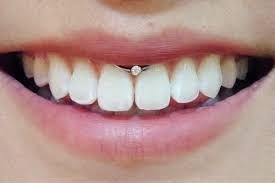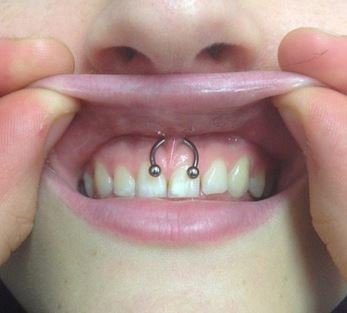What is Smiley Piercing?
When you stretch your tongue and stick it over the top part of the front teeth, you will see that it rests between the lip and the gums, that’s the area where smiley piercing goes. If you use the tongue to touch the area connecting the gums to the lip you will feel a strip of thin skin. It is called frenulum and forms the spot where smiley piercing it done. This area is most of the time hidden, and the smiley piercing is only seen after you smile at people. And it is this scenario that resulted to the name of the piercing. Smiley piercing is also known as scrumper piercing.1,2,3


Smiley piercing has become popular since its introduction decades ago and it provides a little secret for you that you can decide when to reveal it – people only see it when you smile.
Today, smiley piercing is a popular oral piercing and a fashion trend which became pronounced in the 1990s. The smile of an individual looks beautiful if they wear jewelry in their frenulum. The jewelry complements the teeth and lips of the person thus adding an aura to their personal beauty or appearance.3
How is Smiley Piercing Done?
When you go for a smiley piercing, the piercer looks at your frenulum and see if it’s thick enough to allow the piercing. Some people may not have it done if their frenulum is quite thin. The piercer will not consider doing the piercing if he or she finds that your frenulum is not strong to hold your jewelry.
Some piercers may tell you it’s okay to do the piercing even when the frenulum is thin, but you are risking having the piercing or jewelry tear your frenulum. It’s better you consider a different piercing if the piercer tells you that you won’t be able to get a smiley piercing. They are the experts and you should respect their opinion. The smiley piercing procedure is as follows:1
- A piercer gives you a rinse of the mouth using an antibacterial agent
- The needle that goes through frenulum is sterilized to make sure there aren’t harmful microbes like bacteria
- The piercer then pierces or punctures the frenulum while holding back the upper lip to ensure the area is well exposed
- It only takes a few seconds for the needle to go in and out
- When done with the piercing, the piercer inserts the jewelry into the hole
- After that, you will have instructions on how to take care of the new piercing. You should make sure you follow those instructions to avoid having after-piercing complications.
How Much Does Smiley Piercing Hurt?
When having a smiley piercing, the pain is relative. Some people are more tolerant to pain than others and so the smiley piercing pain will largely depend on pain tolerance levels. If you can tolerance pain, you will have little discomfort. Even people who are scared of piercings, they can pretty well sail through the experience. Remember that any piercing can cause pain because you are having sharp needles being driven through sensitive tissue. That said, you realize that a smiley piercing may not be as painful as other types of piercings.
While smiley piercing are done on a sensitive area, it is also important to know that the frenulum doesn’t have a very thick strip of skin, so it does not take a lot of time for the needle to drive through. This somewhat helps to reduce the level of pain you have. There is no much pressure exerted to the tissue when piercing.
A piercer will obviously prepare you psychologically for the piercing, so you shouldn’t panic about it. Just relax and imagine of other things rather than worrying about the pain. Think of how the cool the new piercing is going to appear thereafter.
Having a weak, thin frenulum may not sustain the pressure that is put when piercing and later on the jewelry may even tear it apart. A well-trained piercer should do the piercing to ensure it is done the right way and avoid complications.1,2
You may not even compare the smiley piercing pain with an ordinary injection, it is milder. However, the pain may be higher if you have the piercing getting too close to the lip or gum area. If the needle passes in the middle part of the frenulum, probably you may not feel any pain. Pain may begin to be felt if there is an inflammation or an infection. That said, you can manage any pain and discomfort by using home remedies and aftercare tips.3
What’s the Cost for a Smiley Piercing?
Although a smiley piercing requires accuracy and precision, it’s not usually expensive to have it. A smiley piercing done at a recognized studio would cost somewhere between $30 to $90 dollars. The price range depends on your locality and the level of the studio. If you go to a trendy place, it would cost you closer to the upper end of the cost indicated.
If you reside in a rural area, it can cost you closer to the lower end. In-demand experts may sometimes charge more so you may want to compare the prices but you don’t compromise on the quality of service you get. Before you can commit yourself to a piercer, you should first look at the level of sterilization of the tools and equipment they use.1,2
Use of sufficiently sterile equipment ensures that you don’t get infection in the site of piercing. It also prevents the possibility of having unwanted side effects, for example a disease such as hepatitis C.
Things to Do Before a Smiley Piercing
If you are thinking of having a smiley piercing, you want to understand what it is and the potential risks it may carry. You are able to make an educated decision if you know what to expect from the piercing and the risks involved. Some people can handle the pain and stress associated with a smiley piercing than others.
Risks of a Smiley Piercing – Migration and Rejection
While having a smiley piercing is a cool thing, there are potential risks that come with it. It is common to have rejection and migration of the piercing because the tissue involved is not as thick as other tissues. Many piercing can migrate, but where there is thin tissue being punctured or pierced, the chances of the jewelry being pushed out of the tissue are higher. When you notice the jewelry has started coming out, go to the piercer and seek help.2,3
Another problem is that when you wear a circular beaded ring or captive bead ring (CBR), the ball can potentially rub against the teeth and gums. Over time, the rubbing may cause the gums to start receding. If this happens, you should consider smiley piercing removal.
Also, when the jewelry rubs the teeth, it may begin to wear out the enamel of the teeth. If the piercing has begun changing its position or migrating, you want to observe how the CBR positions itself. If there is rubbing against the teeth, it is better you think of having a curved barbell or alternatively remove it.
The risks associated with a smiley piercing are one reason why the wearers don’t wear it for a long time.
Pros of Smiley Piercing
There is no doubt that a smiley piercing is done on a sensitive part, but why do people still adorn and love it? There are many pros of having this kind of oral piercing and they include:3
- It heals fast
- Has a wide range of jewelry
- It complements the appearance of the lips and teeth
- It needs minimal piercing because of the relatively thin tissue of the frenulum
- It has hidden piercing that only appears when you smile, so you can simply decide to hide it if you like.
Cons of Smiley Piercing
There are many benefits of having smiley piercing, especially the minimal piercing and beauty part of it. However, there are also cons that come with it and they include:3
- It can cause pain along with an infection – also other piercings have a risk of infection
- It has the potential of migrating and rejection because of the thin tissue
- You cannot have it on a weak, thin frenulum
- There are risks of having irreversible tooth and gum damage if you don’t watch over how it changes the position and whether or not it rubs against tooth and gum
- The piercing limits free movement of your upper lip.
Aftercare Tips for Smiley Piercing
To avoid having an infection and allow the piercing to heal fast, there are important aftercare tips you should observe at home. 1,2,3,4,5
- Give a minimum of four weeks of great care to the new piercing
- You should clean your mouth and gums at least 2 times a day using non-alcoholic mouthwash. You may also use distilled saline solution
- Refrain from smoking after having the piercing until it has fully healed. Smoking can lengthen the healing time and irritate the pierced tissue.
- Avoid consuming alcohol and hot or spicy foods because they can irritate the newly pierced tissue
- Don’t allow food particles to build up in the area of piercing, they may encourage bacterial infection
- When rinsing the mouth, do not use force
- You can use sea-salt water when rinsing the mouth but make sure that you dilute it – get a quarter teaspoon of non-iodized sea-salt and dilute it using 8 ounces of water.
- You should refrain from playing with your jewelry, it is common for people to want to use the tongue to touch or push the jewelry. Don’t do that!
- Don’t get into long conversations or arguments with others because the more a person talks when they wear smiley piercing, the more likely they irritate it. Allow yourself time to heal before you can do these practices.
- Don’t kiss, not before you have healed. So allow yourself some weeks of loneliness. When you kiss, there is exchange of saliva and it could cause an infection if the person you are kissing has microbes likely to cause infections. And you know the mouth contains many bacteria.
- Don’t even think of oral sex during the time the piercing is healing.
Jewelry for Smiley Piercing
There are many options for jewelry when doing a smiley piercing. The most common one is the captive bead ring, which is of the size 16 to 18 gauge. A horseshoe barbell is also another option. When choosing the jewelry, make sure that the diameter of its ring does not go above half an inch. It is advised that you use a small gauge size if you are doing the piercing for the first time.3
If you happen to experience itchiness or you suspect that you have an allergy reaction, you need to see your piercer and ask if there could be something else to swap with that does not trigger a reaction.1,2,3,4,5
Choosing jewelry made of stainless steel or gold helps avoid allergy reactions or infection.
Smiley Piercing Infections
Although you may not get an infection, it doesn’t mean that you should not take good care of the piercing. Because a smiley piercing involves puncturing the frenulum tissue, if you don’t observe the aftercare instructions, you could get an infection. While it is easy to spot an infection with ear piercings or some other skin piercings, for the case of a smiley piercing, it may not be easy. The piercing is in a hidden area and to have a good view of the piercing site, you need to pull the lip upward and away from the teeth. Examining the frenulum may help you see any signs of an infection. The presence of an infection may manifest with symptoms such as: 1,3,4,5
- Swelling
- Discharge coming out
- Redness
- Extreme pain.
If there is an infection, you need to consult with a doctor. Prescription antibiotics may be needed to help treat the infection. Don’t let an infection continue to persist in your mouth because it can quickly get out of control leading to a potentially disfiguring situation.
When to Change a Smiley Piercing?
You should change the piercing only after it has healed. The good thing about the smiley piercing is that it takes a short time to heal. In about 4 to 8 weeks, you should have it healed and that’s the time you can change the jewelry and get a new one.3
- You should not change the jewelry before the piercing heals because it can cause pain, swelling and infection.
- Before you touch the jewelry, make sure you wash the hands using an antibacterial soap. Once you remove the old jewelry, the new one should be inserted immediately.
- While you may consider increasing the size of the jewelry, it is better you use the same gauge as the previous one.
- Get the help of a piercer when you want to change the jewelry, especially if it is your first time.
- Sometimes, you may have to remove the jewelry before the healing time if it is found that you are allergic to the material.
Your jewelry should comprise of materials that don’t irritate the gums and lips such as copper and titanium. You may also consider smiley piercing jewelry consisting of materials like platinum, sliver, or gold. Instead of captive bead rings, you can wear barbells or studs.
Reference List
- Smiley Piercing Guide With Beautiful Images. https://authoritytattoo.com/smiley-piercing/
- So What Is A Smiley Piercing? https://www.webpiercing.com/smiley-piercing/
- Smiley Piercing – Infection, Pain, Risks, Caution And Jewelry. https://www.authorityhealthmag.com/smiley-piercing/
- Show Your Tracking Modern Trend of Smiley Piercing. https://www.piercingeasily.com/smiley-piercing/
- Your Complete Guide to Smiley Piercing: Pain, Price, and Ideas. https://ritely.com/smiley-piercing/







Quando uma pessoa usa o piercing no Smiley, ela corre o risco de ferir alguém durante o beijo?